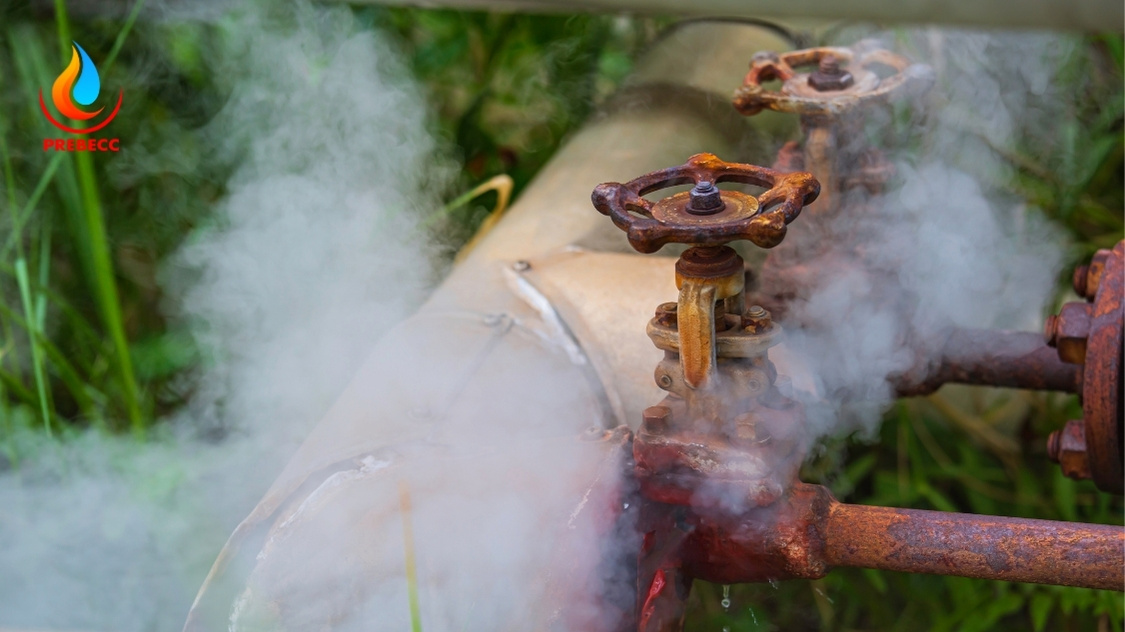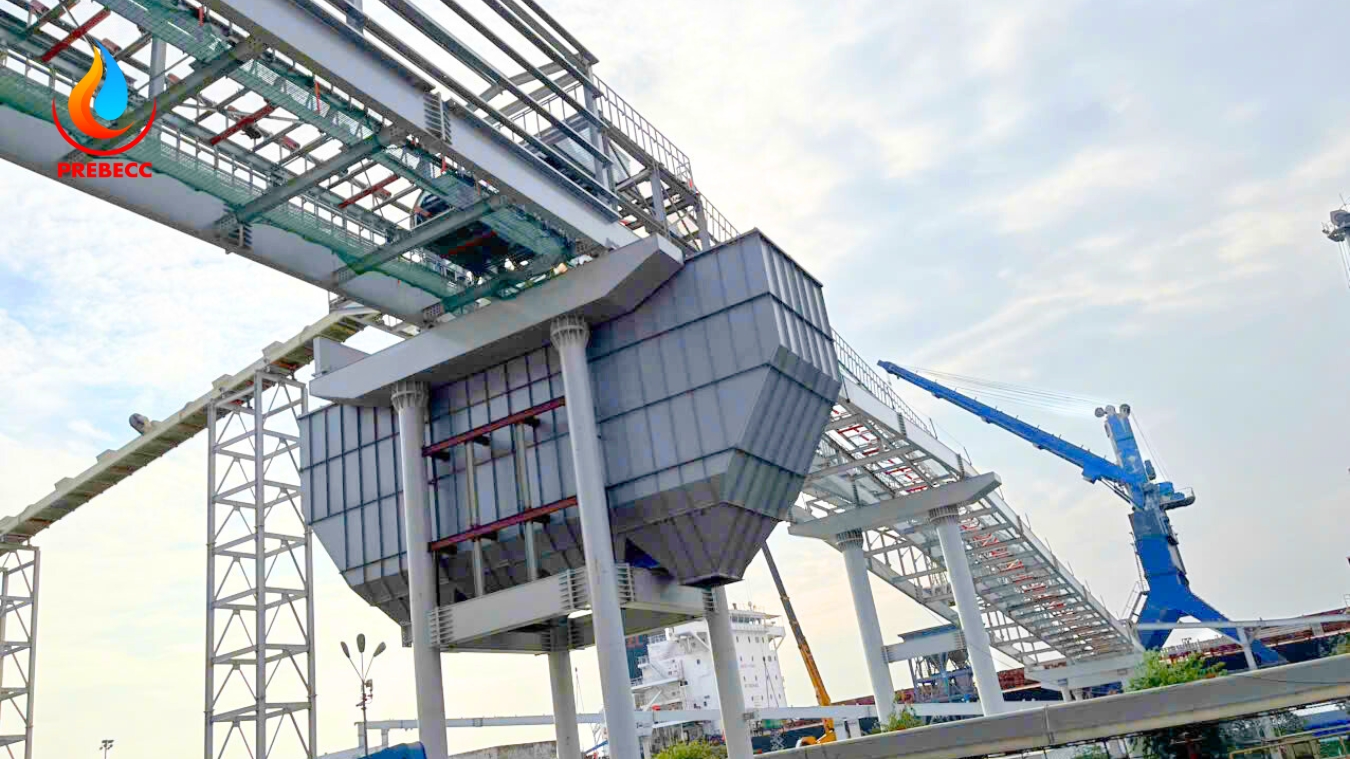Corrosion in industrial pipelines is a serious issue that many businesses face. It not only reduces the lifespan of pipeline systems but can also lead to severe incidents such as leaks, pipeline explosions, environmental pollution, and economic losses. Identifying the causes of corrosion is the first and most crucial step in developing solutions to protect pipelines, ensuring safety and operational efficiency.
So, what are the most common causes of pipeline corrosion?
1. Common causes of industrial pipeline corrosion
1.1. Chemical corrosion
This type of corrosion occurs due to chemical reactions between the pipeline material and substances in the surrounding environment. Some key factors include:
- Effects of Acids and Alkalis: Many pipeline systems transport highly acidic or alkaline chemicals, which accelerate metal corrosion. For example, in the petrochemical industry, sulfuric acid or hydrochloric acid can rapidly degrade pipeline surfaces.
- Oxidation: When metals are exposed to oxygen in the air or water, oxidation occurs, forming corrosion products such as rust (Fe₂O₃). This is particularly common in pipelines carrying water or moisture-laden gases.
1.2. Electrochemical corrosion
Electrochemical corrosion occurs when there is a potential difference between different sections of a pipeline or between dissimilar metals in an electrolyte environment. Some typical forms include:
- Potential Difference Corrosion: Due to variations in material composition or environmental conditions, certain areas on the pipeline surface may act as an anode while others act as a cathode, forming a corrosion current.
- Galvanic Corrosion: When two metals with different electrical potentials come into contact in a moist or electrolyte-containing environment, electric current flows from the higher-potential metal to the lower-potential metal, accelerating the corrosion of the weaker metal. For example, if a steel pipeline is connected to copper fittings in a seawater environment, the steel will corrode faster due to galvanic effects.
1.3. Mechanical corrosion
Physical impacts can also degrade pipelines through various mechanisms:
- Erosion Corrosion: In pipelines transporting liquids or gases containing solid particles (such as sand, dust, or sludge), continuous friction between these particles and the pipe surface can lead to material loss, thinning of the pipe wall, and eventual failure.
- Impact Damage: High flow velocities, sudden pressure fluctuations, or external forces (such as vibrations from machinery) can cause micro-cracks on the pipe surface, providing entry points for corrosion.
- Vibration-Induced Corrosion: Particularly in high-pressure pipeline systems, vibrations from pumps or mechanical equipment can create fatigue cracks, accelerating corrosion.
1.4. Microbiologically influenced corrosion (MIC)
The growth of bacteria and fungi in pipelines can also lead to corrosion, especially in humid and low-oxygen environments. Some bacteria produce sulfuric acid or organic acids, which degrade metal surfaces over time. MIC is commonly found in water treatment systems, oil and gas pipelines, and the food processing industry.
1.5. Environmental factors
Apart from the causes mentioned above, environmental factors also play a significant role in pipeline corrosion:
- Temperature: High temperatures can accelerate chemical reactions, speeding up the corrosion process. In industrial settings, steam or hot chemical pipelines tend to corrode faster than those operating at normal temperatures.
- Humidity: Pipelines exposed to high humidity are more susceptible to corrosion due to the formation of conductive water films on metal surfaces, facilitating oxidation and electrochemical reactions.
- pH Levels: Acidic or alkaline environments can destroy the protective layers of metals, increasing corrosion rates. For instance, pipelines in chemical processing plants or wastewater treatment facilities often face high corrosion risks due to constant pH fluctuations.

2. Factors affecting corrosion rate
The corrosion rate of industrial pipelines is influenced not only by the underlying corrosion mechanisms but also by various external factors. Understanding these factors enables businesses to implement effective control measures and mitigate risks.
2.1. Pipeline material
The material used in pipeline construction plays a crucial role in corrosion resistance. Some common materials and their corrosion resistance levels include:
- Carbon Steel: Widely used across industries due to its affordability and strength but highly susceptible to corrosion, especially in high-humidity or chemically aggressive environments.
- Stainless Steel: Offers excellent corrosion resistance due to its protective chromium oxide layer; however, it can still suffer from crevice corrosion and pitting in chloride-rich environments.
- Cast Iron: More resistant to corrosion than carbon steel but prone to brittleness, making it unsuitable for environments with large temperature fluctuations.
- Copper & Copper Alloys: Provide good corrosion resistance in seawater environments but can experience galvanic corrosion when in contact with dissimilar metals.
- Polymer & Composite Materials (e.g., PVC, HDPE, FRP): Exhibit superior chemical corrosion resistance but lack durability under high temperature and pressure conditions.
Selecting the appropriate material depends on operating conditions, environmental exposure, and the technical requirements of each pipeline system.
2.2. Properties of transported fluids/gases
The medium flowing through the pipeline directly impacts the extent and rate of corrosion. Key influencing factors include:
- Chemical Composition: Acidic, alkaline, saline, or strongly oxidizing substances accelerate metal corrosion. For instance, natural gas pipelines containing H₂S corrode rapidly due to reactions with iron, forming iron sulfide deposits.
- Temperature: Higher temperatures increase the rate of chemical and electrochemical reactions, accelerating corrosion. Steam pipelines or systems transporting hot chemicals require specialized heat-resistant and corrosion-resistant materials.
- Flow Velocity:
- Low Flow Rates: Encourage sediment buildup, creating an environment conducive to microbiologically influenced corrosion (MIC).
- High Flow Rates: Lead to erosion corrosion, where high-velocity fluid impacts pipeline walls, thinning the material and accelerating mechanical degradation.
2.3. Operating conditions
Beyond material selection and environmental exposure, operational factors also significantly affect pipeline corrosion rates:
- Pressure: High-pressure pipelines are susceptible to corrosion fatigue, caused by the combined effects of mechanical stress and chemical corrosion.
- Maintenance Frequency: Lack of regular inspections and maintenance can lead to undetected localized corrosion, oxidation, and deposit accumulation, increasing the risk of severe failure.
By considering these factors, industries can optimize pipeline design, material selection, and maintenance strategies to extend pipeline lifespan and enhance operational reliability.
3. Corrosion prevention and mitigation measures
Preventing and controlling corrosion in industrial piping systems requires a comprehensive strategy—from material selection to maintenance and environmental control. Below are effective measures to minimize corrosion impact and extend pipeline lifespan.

3.1. Selecting suitable materials
Choosing the right material is a fundamental step in minimizing corrosion risks. Key considerations include:
- Stainless Steel: Ideal for highly corrosive environments, such as acid-handling or seawater systems.
- High-Alloy Materials: Nickel, titanium, and copper-nickel alloys provide enhanced corrosion resistance in specialized conditions.
- Chemical-Resistant Polymers (e.g., PVC, PTFE, HDPE, FRP): Suitable alternatives to metals in chemical transport systems to prevent chemical corrosion.
- Buried Pipelines: Require materials resistant to electrochemical corrosion, such as plastic-coated steel or galvanized steel.
3.2. Applying protective coatings
Coatings act as a barrier, preventing direct contact between metal surfaces and corrosive environments:
- Protective Paint Coatings: Epoxy, polyurethane, and vinyl-based coatings provide strong surface protection.
- Metallic Coatings: Galvanization (zinc coating) or aluminum coating enhances corrosion resistance in carbon steel.
- Polymer Linings: Internal plastic linings protect pipelines from aggressive chemical exposure.
3.3. Environmental control
Minimizing environmental factors that accelerate corrosion can significantly improve pipeline durability:
- pH Regulation: Maintaining an optimal pH level in liquid systems reduces chemical corrosion.
- Temperature Control: Lowering temperatures where feasible slows oxidation and metal degradation.
- Humidity Reduction: For pipelines exposed to air, insulation, ventilation, or moisture-resistant coatings help mitigate corrosion risks.
3.4. Regular maintenance and monitoring
Routine inspections and maintenance help detect early signs of corrosion, allowing timely interventions:
- Ultrasonic Thickness Testing (UTT): Uses ultrasound waves to measure pipe thickness and identify severe corrosion zones.
- Leak Detection: Pressure testing and infrared scanning can pinpoint leaks caused by corrosion damage.
- Periodic Cleaning and Maintenance: Removes deposits and impurities that may cause localized corrosion, while assessing high-risk areas.
3.5. Using corrosion inhibitors
Corrosion inhibitors slow or prevent corrosion reactions by forming a protective layer on metal surfaces:
- Anodic Inhibitors: Reduce oxidation at the anode, commonly containing chromate or nitrate compounds.
- Cathodic Inhibitors: Minimize reduction reactions at the cathode, often utilizing zinc or phosphate-based chemicals.
- Volatile Corrosion Inhibitors (VCI): Create protective vapor-phase barriers for pipelines in storage or intermittent operation.
By implementing these measures, industries can effectively combat corrosion, ensuring pipeline longevity and operational reliability.
4. Prebecc’s industrial piping installation services – Ensuring quality and durability
With years of expertise in the heavy industry sector, Prebecc is proud to offer industrial piping installation, construction, and maintenance services that adhere to the most stringent technical standards. Our solutions are not only technically compliant but also optimized for safety, durability, and long-term operational efficiency.
4.1. International standard piping installation
Prebecc ensures high-quality pipeline construction by adhering to global standards and employing advanced technologies:
- Compliance with Technical Standards: Our piping systems meet international standards such as ASME B31.3, API 570, and EN 13480, ensuring resistance to pressure, temperature, and corrosion.
- Cutting-Edge Technologies: We utilize automated welding techniques, ultrasonic weld inspection (UT), and radiographic testing (RT) to guarantee airtight and robust pipeline structures.
- Experienced Engineering Team: Our team consists of skilled engineers and certified technicians dedicated to delivering high-precision and durable installations.

4.2. Advanced corrosion prevention from design to execution
Recognizing that corrosion is a leading cause of pipeline deterioration, Prebecc integrates preventive measures from the design and construction phase:
- Material Selection: We choose corrosion-resistant materials suited to operational environments, including stainless steel, corrosion-resistant alloys, and high-performance polymers.
- Protective Coatings: Our pipelines feature epoxy coatings, hot-dip galvanization, and anti-corrosion plastic linings for enhanced durability.
- Smart Drainage and Ventilation Design: Our designs incorporate effective drainage and ventilation systems to minimize moisture buildup and environmental damage.
4.3. Industrial pipeline maintenance and upgrades
Beyond installation, Prebecc offers comprehensive maintenance, inspection, and upgrade services to extend pipeline lifespan and ensure stable operations:
- Regular Inspections: Utilizing ultrasonic testing (UT), X-ray inspection (RT), and hydrostatic pressure testing, we detect potential issues before failures occur.
- Repair & Replacement: We perform corrosion-related repairs, pipe replacements, and structural reinforcements according to safety standards.
- System Upgrades: Our team modernizes aging pipeline systems by improving material quality and applying the latest anti-corrosion technologies.
By choosing Prebecc, you ensure high-performance, long-lasting, and safe industrial piping solutions tailored to your operational needs.
